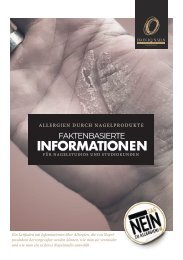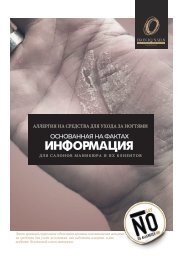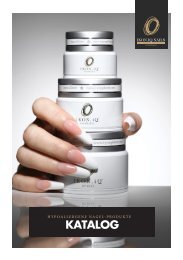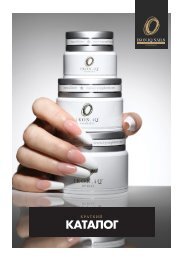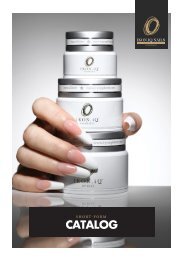Nail Product Allergies
Short guide with advice on what causes nail product allergies, how to avoid them and how to choose a safe nail salon.
Short guide with advice on what causes nail product allergies, how to avoid them and how to choose a safe nail salon.
Create successful ePaper yourself
Turn your PDF publications into a flip-book with our unique Google optimized e-Paper software.
IKON.IQ NAILS<br />
NAIL DESIGN EXCELLENCE<br />
STOCKHOLM<br />
NAIL PRODUCT ALLERGIES<br />
FACT-BASED<br />
INFORMATION<br />
F O R N AIL SAL O N S AND SAL O N CUSTO MERS<br />
Short guide with advice on what causes nail product allergies,<br />
how to avoid them and how to choose a safe nail salon.
What is an<br />
skin contact allergy?<br />
—<br />
A skin contact allergy is a reaction<br />
by the immune system that is trying<br />
to protect us from potentially harmful<br />
substances that can be liquids or<br />
solids. These substances are called<br />
allergens or sensitisers and most<br />
of them occur in nature! Allergen<br />
examples include nickel, latex, bee<br />
stings, pollen, etc.<br />
Unfortunately, while the immune<br />
system has good intentions, it is not<br />
very smart! So it can get fooled by<br />
synthetic (man-made) substances<br />
that it thinks are one of natures<br />
potentially harmful substances.<br />
—<br />
<strong>Allergies</strong> don’t appear overnight;<br />
they can take months or years<br />
to develop. But once an<br />
allergy occurs, it is for life.<br />
The immune system will neer forget that<br />
specific allergen. Even if there is no skin<br />
contact with the allergen for a period of<br />
time, the smallest skin contact can trigger<br />
the allergic reaction again.<br />
Worse still, once an allergy develops,<br />
the immune system goes onto heightened<br />
alert, so it becomes much easier and faster<br />
to develop allergies to other allergens in<br />
future.<br />
It is a common misunderstanding that<br />
nailproducts cause allergies This is not<br />
correct, an allergy is a reaction to one<br />
or more specific ingredients in the nail<br />
products that you use.<br />
It starts with Over Exposure!<br />
Before an allergy occurs, there is a long<br />
and repeated period of skin contact with the<br />
allergen. During this period of over<br />
exposure the skin will show signs of<br />
irritation, redness or inflammation.<br />
—<br />
Only if these symptoms are ignored,<br />
will an allergy finally develop.<br />
So allergies are entirely<br />
preventable.<br />
An allergy can’t be caused by a<br />
chemical vapour. Chemical vapours<br />
from the nail products can’t<br />
cause an allergy, but inhaling<br />
vapours or dust can cause other<br />
lung illnesses such as asthma,<br />
chemical pneumonia and chronic<br />
obstructive pulmonary diso der<br />
(COPD). COPD can be life<br />
threatening.<br />
—
How to avoid<br />
an allergy?<br />
Remember that to become over exposed<br />
and develop an allergy, means that<br />
there has been prolonged and repetitive<br />
skin contact with uncured or undercured<br />
nail product, or product dust. So<br />
taking steps to avoid skin contact is the<br />
#1 priority!<br />
Nitrile gloves<br />
Do wear nitrile gloves. These should<br />
conform to the EU Chemical Resistance<br />
specification EN 374-3 or higher. Or if<br />
in doubt select a glove that is at least<br />
8mil / 0.19mm thick. Or double-glove<br />
with thinner gloves. Longer cuff gloves<br />
give more protection.<br />
Dispose of the gloves after each client.<br />
Barrier cream<br />
As an extra layer of protection, consider<br />
wearing a skin barrier cream under<br />
the gloves and on your arms. This is<br />
NOT an alternative to wearing nitrile<br />
gloves. But as you probably use hand<br />
cream anyway, it makes sense to use a<br />
barrier cream, that will also help you<br />
to avoid eczema from frequent hand<br />
washing.<br />
Use the correct UV lamp<br />
According to the<br />
British Association of<br />
Dermatologists, the<br />
number of reported<br />
nail product allergies<br />
has reached epidemic<br />
levels. The #1 cause<br />
is using the wrong UV lamp for the gels<br />
and gel polishes, as this often causes<br />
under-cured gel dust.<br />
Not all dust is visible. If you use an<br />
e-File, this also creates invisible dust<br />
that will float in the air. With each<br />
client this dust pollution increases in<br />
the salon. This invisible dust will land<br />
on any skin that is exposed, including<br />
According to the British Association of Dermatologists, the three main nail<br />
product ingredients that cause skin contact allergies are:<br />
• 2-Hydroxyethyl Methacrylate (HEMA)<br />
• 2-Hydroxypropyl methacrylate (2-HPMA)<br />
• Ethyl Acrylate<br />
the chest area, neck and face, and can<br />
cause a reaction in those areas.<br />
Tidyness<br />
Keep the nail desk clean and free from<br />
dust and change the disposable towel<br />
after every clients. Otherwise it is too<br />
easy, especially in summer, to rest an<br />
bare arm on this dust and develop<br />
an allergic reaction there, like in the<br />
photo<br />
above.<br />
If you wipe monomer in your brush<br />
onto a pad, be careful not to rest your<br />
arm in this.<br />
Client<br />
Avoid the skin surrounding the nail<br />
during application.<br />
Wiping the inhibition (sticky) layer.<br />
When wiping the gel or gel polish<br />
inhibition layer, start with the smallest<br />
finger and wipe from the cuticle to the<br />
free edge to avoid dragging the wiping<br />
liquid and dissolved uncured gel onto<br />
the clients skin. Wipe the remaining<br />
fingers of that hand from small to big.<br />
Then use a fresh pad to wipe the other<br />
hand and repeat this procedure.<br />
What to do if you think you<br />
might have an allergy<br />
1. Visit a dermatologist. They will<br />
test which ingredient(s) you<br />
react to.<br />
2. Find products that don’t contain<br />
them (this group can help)<br />
3. Change behaviour. Wear nitrile<br />
gloves at least 0.19mm thick or<br />
double-glove. Use one brand<br />
of gels/gel-polishes and use<br />
recommended UV lamp. Invest in<br />
an air filter system that contains<br />
HEPA dust filters and at least<br />
1kg active carbon filter - cheaper<br />
that having to change career<br />
and having to dispose of all your<br />
nail products.
Choosing a safe<br />
nail salon<br />
Look out for the red flags!<br />
1. Does the salon have a chemical smell?<br />
2. Are the same nail files and tools used on<br />
multiple customers?<br />
3. Are education certificates displayed in visible sight?<br />
4. Are the working surfaces clean and dust free?<br />
5. Were you asked to wash your hands?<br />
6. Did they spray sanitiser liquid on your hands after<br />
washing?<br />
7. Did the <strong>Nail</strong> Technician wash their hands?<br />
8. Does the <strong>Nail</strong> Technician wear gloves?<br />
9. Is the <strong>Nail</strong> Technician using gel, acrylic or gel polish<br />
from brand labelled jars or bottles?<br />
10. Do you feel pain after the artificial nails have been<br />
applied?<br />
Possible infections<br />
include:<br />
1. Hepatitis<br />
2. e.Coli<br />
3. Staphylococcus aureus<br />
4. TB<br />
5. HIV 1<br />
6. Hepatitis C<br />
7. MRSA<br />
About<br />
The “Say No To <strong>Allergies</strong>” campaign is a brand and product neutral campaign created by Iryna and Bob<br />
Giblett, in response to the British Association of Dermatologists recent statement that “nail product allergies<br />
have reached epidemic levels”. The objective of this compaign is to provide fact-based information to<br />
both <strong>Nail</strong> Salons and nail salon clients so that both can make better informed choices.<br />
Iryna is a veteran <strong>Nail</strong> Technician, Competition Judge and Competition Champion who studied Chemistry<br />
and Biology. Prior to becoming a <strong>Nail</strong> Technician, Iryna worked as a Microbiologist at the government<br />
health laboratory in Kyiv, Ukraine.<br />
Bob is an engineer who also works in the nail industry. He is enjoys writing articles for nail magazines and<br />
is a regular poster on Facebook, sharing advice on the prevention of nail product allergies and the<br />
European Cosmetics directive.<br />
For additional support and advice, we welcome <strong>Nail</strong> Technicians to the following Facebook group:<br />
https://www.facebook.com/groups/nail.product.allergies/<br />
www.saynotoallergies.today






